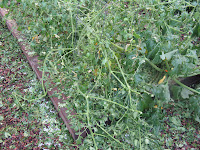 It's nice to see something green in the vegetable plots in winter and hairy vetch, Vicia villosa, performs well as a cover crop. It is is a high N producer, vigorous grower, very drought tolerant, prospers in low fertility and a wide range of soil conditions, and is winter hardy to zone 4 with snow cover.
It's nice to see something green in the vegetable plots in winter and hairy vetch, Vicia villosa, performs well as a cover crop. It is is a high N producer, vigorous grower, very drought tolerant, prospers in low fertility and a wide range of soil conditions, and is winter hardy to zone 4 with snow cover.One of the best things about fall planted hairy vetch is that it provides improvements in crop yields greater than the nitrogen added by it's symbiotic nitrogen-fixing bacteria alone. This may be due to root penetration that leads to better vegetable root development, physical soil improvement that allows a better air-moisture balance for crop roots in soil, improved soil biological activity or other reasons.
Note that hairy vetch doesn't build up long-term soil organic matter. It is a essentially a succulent plant that has a relatively low carbon to nitrogen ratio in the range of 8:1 to 15:1. Most benefits are realized by the first vegetable crop that follows in spring. For this reason it is often interplanted with winter rye, Secale cereale, that has a higher C:N ratio (ranging from 25:1 to 55:1) and thus breaks down more slowly. The combination planting results in some of the best of both worlds - N contribution plus short and longer term organic matter increase.
Hairy vetch growth is almost non-existent in mid-winter but will increase with lengthening days. Mow and turn it under at 25% bloom when N contribution will be maximized.
Note that freezing temperatures under 5 degree F can cause some winter kill if there is no snow cover. Temperatures in this range occurred along some parts of the Front Range December 5 and 6 and some damage may be seen. This is another reason to plant with hardy winter rye so an adequate spring yield of biomass can be gained. Next post will highlight workhorse winter rye as a cover crop.
Photo credit: Hairy vetch closeup - Carl Wilson





















































